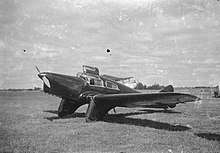Malcolm C. McGregor
Captain Malcolm Charles McGregor DFC* (4 March 1896 – 19 February 1936) was a New Zealand born World War I flying ace. He was credited with 11 victories during the war. Postwar, he was an aviation pioneer in his home country and a competitor in intercontinental air racing.
Malcolm Charles McGregor | |
|---|---|
| Born | 4 March 1896 Vicinity of Hunterville, New Zealand |
| Died | 19 February 1936 (aged 39) Wellington, New Zealand |
| Allegiance | New Zealand |
| Service/ | Aviation |
| Rank | Squadron Leader |
| Unit | No. 54 Squadron RFC, No. 85 Squadron RAF |
| Awards | Distinguished Flying Cross with Bar |
| Other work | Aviation pioneer in New Zealand; long distance air racer |
Early life
Malcolm Charles McGregor was born near Hunterville, New Zealand on 4 March 1896.[1] When grown, he was six feet three inches tall.[2]
World War I
MacGregor was granted his Aero Certificate in September 1916.[2] On 7 April 1917, McGregor was appointed a Flying Officer in the Royal Flying Corps.[3] His first aerial success came on 6 June 1917, while she was with 54 Squadron. He used a Sopwith Pup to destroy a German Albatros D.III fighter southwest of Cambrai, France.[1]
He would not score another victory for almost a year. During this time, he survived being shot down. He was posted for a short time to No. 91 Squadron RAF. After transferring to No. 85 Squadron RAF to pilot a SE.5a, he drove down an enemy reconnaissance plane over Armentières on 29 May 1918. Three days later, on 1 June, he drove down a pair of Pfalz D.III fighters over La Gorgue, France. On 27 June 1918, he destroyed another German recon machine and became an ace.[1][2]
On 24 July, he scored another double win southeast of Kemmel, Belgium, destroying one Fokker D.VII and driving another out of combat. On 3 August, he destroyed a Fokker D.VII. On 10 August, he was again shot down; again, he survived. Later in August, on the 22nd, he destroyed yet another Fokker D.VII. This was the action referred to when he was awarded the Distinguished Flying Cross, which was not gazetted until 2 November 1918.[1][2]
On the 22nd August this officer displayed great gallantry and skill in an engagement between six of our scouts and a similar number of the enemy; all the latter were accounted for, Captain McGregor driving down one out of control. In all he has seven enemy aircraft to his credit—four destroyed and three driven down out of control.[4]
McGregor would next turn balloon buster, destroying an enemy observation balloon east of Maretz, France on 8 October. He ended his string of triumphs by destroying another recon plane on 23 October 1918. His final tally was an observation balloon and five enemy airplanes destroyed, plus four planes driven down out of control.[1][2]
Post World War I
1919
McGregor was one of the officers awarded a Bar to his Distinguished Flying Cross as a birthday gift from his sovereign on 3 June 1919.[5] He was discharged from the Royal Air Force by being placed on the unemployed list on 17 July 1919.[6] He returned to New Zealand to farm.[2]
The 1920s
McGregor joined the Royal New Zealand Air Force in 1921. In 1923, he was appointed Squadron Leader. He also took part in civil aviation activities. He ran a barnstorming operation, Hamilton Airways. He flew a passenger route between Dunedin and Christchurch in a De Havilland DH.50 borrowed from the New Zealand government. He flew some pioneering airmail routes throughout New Zealand.[7][2] In late April 1929, he participated in the New Zealand Air Pageant, entering a de Havilland Gipsy Moth from Hamilton Airways.[8]
The 1930s
By the end of 1931, he was reported carrying air mail from Invercargill, New Zealand to Auckland in a Simmonds Spartan.[9] In 1932, he became chief instructor to the Manawatu Aero Club. While flying with Union Airways, he broke his back in a crash. By 1934, he had risen to the rank of Squadron Leader in the RNZAF, and had 3,300 flying hours in his pilot's log.[7][2]
He was one of the contestants in the MacRobertson Air Race in October 1934.[10] He and his copilot completed the course, Mildenhall to Melbourne, in 7 days 15 hours, in a Miles Hawk Major.[11] Following the race, he became a director of Union Airlines of New Zealand.[12]

McGregor died in hospital after the wing tip of his fast Miles monoplane hit the anemometer mast in gusty weather at Rongotai airport, Wellington, New Zealand on 19 February 1936.[13][12]
References
- "Malcolm McGregor". The Aerodrome. Retrieved 2 February 2018.
- Shores, Christopher F.; Franks, Norman; Guest, Russell F. (1990). Above the Trenches: a Complete Record of the Fighter Aces and Units of the British Empire Air Forces 1915–1920. London, UK: Grub Street. p. 275. ISBN 978-0-948817-19-9.
- "No. 30047". The London Gazette (Supplement). 3 May 1917. p. 4198.
- "No. 30989". The London Gazette (Supplement). 2 November 1918. p. 12969.
- "No. 31378". The London Gazette (Supplement). 3 June 1919. p. 7031.
- "No. 31478". The London Gazette. 29 July 1919. pp. 9589, 9592.
- Flight, 11 October 1934 Retrieved 26 April 2011.
- Flight, 13 June 1929 Retrieved 26 April 2011.
- Flight, 26 December 1931 Note: The Spartan is referred to in the reference by engine type rather than maker, but is obviously a Simmonds Spartan Retrieved 26 April 2011.
- Flight, 18 October 1934 through Retrieved 23 April 1918.
- Flight, 1 November 1934 Retrieved 23 April 2011.
- Flight, 27 February 1936 Retrieved 26 April 2011.
- The Evening Post 20 February 1936. Monoplane Wrecked. Pilot and Union Airways director, Squadron-Leader McGregor, dies later; only passenger, C W F Hamilton, escapes serious injury